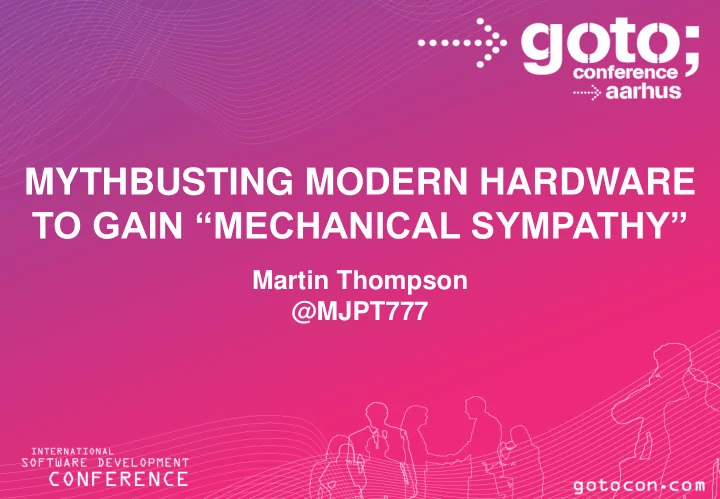

MYTHBUSTING MODERN HARDWARE TO GAIN “MECHANICAL SYMPATHY” Martin Thompson @MJPT777
Myth - 1 “CPUs are not getting faster”
Myth 1 – “CPUs Are Not Getting Faster” • “ The Free Lunch Is Over ” – Herb Sutter > The issue is clock speeds cannot continue to get faster. > However clock speeds are not everything! • Let’s word split of the “Alice in Wonderland” text Processor Model Operations/sec Release Intel Core 2 Duo CPU P8600 @ 2.40GHz 1434 (2008) Intel Xeon CPU E5620 @ 2.40GHz 1768 (2010) Intel Core CPU i7-2677M @ 1.80GHz 2202 (2011) Intel Core CPU i7-2720QM @ 2.20GHz 2674 (2011)
Myth 1 – “CPUs Are Not Getting Faster” Nehalem 2.8GHz ============== $ perf stat <program> 6975.000345 task-clock # 1.166 CPUs utilized 2,065 context-switches # 0.296 K/sec 126 CPU-migrations # 0.018 K/sec 14,348 page-faults # 0.002 M/sec 22,952,576,506 cycles # 3.291 GHz 7,035,973,150 stalled-cycles-frontend # 30.65% frontend cycles idle 8,778,857,971 stalled-cycles-backend # 38.25% backend cycles idle 35,420,228,726 instructions # 1.54 insns per cycle # 0.25 stalled cycles per insn 6,793,566,368 branches # 973.988 M/sec 285,888,040 branch-misses # 4.21% of all branches 5.981211788 seconds time elapsed
Myth 1 – “CPUs Are Not Getting Faster” Sandy Bridge 2.4GHz =================== $ perf stat <program> 5888.817958 task-clock # 1.180 CPUs utilized 2,091 context-switches # 0.355 K/sec 211 CPU-migrations # 0.036 K/sec 14,148 page-faults # 0.002 M/sec 19,026,773,297 cycles # 3.231 GHz 5,117,688,998 stalled-cycles-frontend # 26.90% frontend cycles idle 4,006,936,100 stalled-cycles-backend # 21.06% backend cycles idle 35,396,514,536 instructions # 1.86 insns per cycle # 0.14 stalled cycles per insn 6,793,131,675 branches # 1153.565 M/sec 186,362,065 branch-misses # 2.74% of all branches 4.988868680 seconds time elapsed
Myth - 1 “CPUs are not getting faster”
Myth - 2 “Memory Provides Random Access”
Myth 2 – “Memory Provides Random Access” • What do we mean by “ Random Access ”? > Should it not really be “ Arbitrary Access ”? > Ideally we would like O(1) latency, where 1 is small Speed Power Cost CPU Registers & Buffers L1 Cache L2 Cache L3 Cache Main Memory Local Storage Remote Storage
Memory Ordering Core 1 Core 2 Core n Registers Registers Execution Units Execution Units Store Buffer Load Buffer MOB MOB LF/WC LF/WC L1 L1 Buffers Buffers L2 L2 L3
Cache Structure & Coherence L0(I) – 1.5k µops MOB 64-byte “Cache - lines” 128 bits 16 Bytes TLB LF/WC Pre-fetchers L1(I) – 32K Buffers L1(D) - 32K 256 bits 128 bits SRAM TLB Pre-fetchers L2 - 256K 32 Bytes Ring Bus QPI Bus QPI MESI+F Memory State Model Controller Memory Channels L3 – 8-20MB System Agent
Main Memory Memory Controller Channel Channel Channel Channel Write Buffer Bank Select, Pre-charge + RAS + CAS Ranks are Banks in parallel Columns Row Buffer Memory Array 4096 * 1024 * 16 Rows DRAM Memory Module Bank 0 Bank 1 Bank n DRAM
Myth 2 – “Memory Provides Random Access” • “ The real design action is in the memory sub-systems – caches, buses, bandwidth, and latency. ” – Richard Sites (DEC Alpha Architect) > No point making faster CPUs when we cannot feed them fast enough • Let’s look at the latencies measured by the SiSoftware tool > Intel i7-3960X (Sandy Bridge E) L1D L2 L3 Memory Sequential 3 clocks 11 clocks 14 clocks 6.0 ns In-Page Random 3 clocks 11 clocks 18 clocks 22.0 ns Full Random 3 clocks 11 clocks 38 clocks 65.8 ns
Myth - 2 “Memory Provides Random Access”
Myth - 3 “HDDs Provide Random Access”
Myth 3 – “HDDs Provide Random Access” Sectors 512/4096 Bytes Command Queue Read/Write Cache + Pre-fetcher Zone Bit Recording (ZBR)
Myth 3 – “HDDs Provide Random Access” What Makes up an IO operation? • Command Overhead > Time for the electronics to process and schedule the request – Sub millisecond • Seek Time 4KB Block > Time to move the read/write arm to the appropriate cylinder > Seek and Settle – 0-6ms Server Drive, 0-15ms Laptop Drive Average Average 10ms latency? <1 MB/s? • Rotational Latency > For a 10K RPM disk a rotation takes 6ms so average will be 3ms • Data Transfer > Dependent on media and interface transfer speeds – 100-200 MB/s
Myth 3 – “HDDs Provide Random Access” Are there tricks to hide latency and increase IOPs? • Dual Actuators/Arms > Half the seek time at increased expense • Multiple Copies of Data > Cut rotational delay at reduced drive capacity and increased write cost • Command Queues > Apply elevator algorithms to smooth out latency which work well • Battery/Capacitor backed Cache > Store up commands to handle burst traffic but not sufficient for sustained load
Myth - 3 “HDDs Provide Random Access”
Myth - 4 “SSDs Provide Random Access”
Myth 3 – “SSDs Provide Random Access” MLC / SLC Cells Logical 2MB Block 256/512 Cells 4096/8192 Deleted means Cells Garbage Collection Row == Page TRIM? 4KB Read/Write Pages - Deleted - File A - Free Space Erase - File B Block!!! - File C
Myth 3 – “SSDs Provide Random Access” Clean Intel 320 SSD Read AnandTech After fill and torture Performance Tests Write Beware Write Amplification!
Myth 3 – “SSDs Provide Random Access” • Random re-writes hurt performance and wear out the drive > Block erase is 2ms! • Reads have great random and sequential performance • Append only writes have great random and sequential performance GC Compaction @40K IOPs Average (ms) Max (ms) Read 4K Random 0.1 - 0.2 2 - 30 Write 4K Random 0.1 - 0.3 2 - 500
Myth - 4 “SSDs Provide Random Access”
Questions? Blog: http://mechanical-sympathy.blogspot.com/ Twitter: @mjpt777
Recommend
More recommend